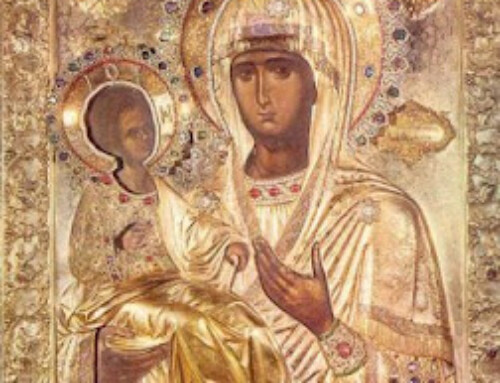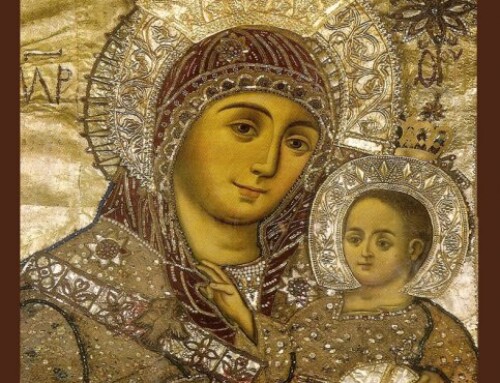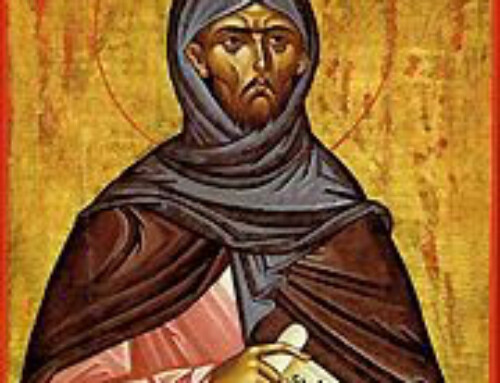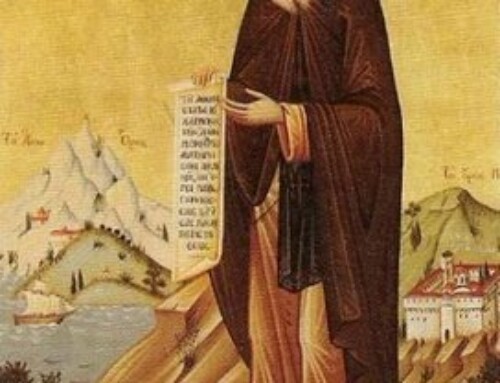Again Magazine Volume 18, Number 1 – March 1995 Page 13-15
SAINT HERMAN of ALASKA
A PILGRIMAGE TO
SPRUCE ISLAND
By Patricia Haley
It was a chilly August morning as my husband, Keith,and I boarded a plane in Anchorage, bound for the island of Kodiak.
Alaska had been our home for many years, but it was not until lately that we began to realize that here in our very own backyard—at least by Alaskan standards!— was the home and burial place of the first Orthodox saint in America, the simple and kindly missionary-monk, Father Herman. So this year we had planned and saved to join the annual pilgrimage to Kodiak and Spruce Island. I was nearly six months pregnant with our first child and we knew that it might be a long time before it was possible for us to make such a journey again.
THE SAINT COMES TO AMERICA
Saint Herman was born around 1756 in the city of Serpukhov near Moscow. Little else is known about his early life, including even his family name. At age sixteen, however, he entered the Trinity-Sergius Hermitage near St. Petersburg. Six years later he transferred to the famousValaam Monastery, well-known in those days for its strictness of life and the spiritual wisdom of its leaders. There, in addition to joining in the routine of prayer and work in the fields and shops, Herman made a name for himself by occasionally wandering off into the woods to pray for days at a time, until his fellow monks would come and retrieve him.
1793, when Herman was thirty-seven years old, the call came from the Holy Synod of Russia asking for missionaries to travel to the distant land of Alaska. Russian explorers and fur-traders had discovered new territories there with vast amounts of seals and otters, as well as a simple and primitive people known as Aleuts. The monk Herman volunteered. By the end of the year he and seven other monks led by Archimandrite Joasaph left their comfortable Valaam and began the long and arduous journey. After hundreds of miles by road, by river, and then by horseback, they finally reached Russia’s eastern shore. There they boarded a trading ship and finally, one month later, on September 24, 1794, arrived in Three Saints Bay at the Russian settlement on Kodiak. Alaska.
When Saint Herman and the other monks from Valaam arrived in 1794 their first task was to build a church in which they could hold services. Then with the help of a translator they began preaching the gospel to the natives. Their success was remarkable. By May, 1795, Archimandrite Joasaph was able to report back to Valaam: “I have, praise God, baptized more than 7,000 Americans, and celebrated more than 2,000 weddings. We have built a Church and, if time allows, we shall build another, and two portable ones, but a fifth is needed. We live comfortably, they love us and we them, they are a kind people, but poor. They take baptism so much to heart that they smash and burn all magic charms given them by the shamans. You frightened us by saying they would be naked but, thank God, they have some conception of good sense: although they are not finely dressed they are at least not naked.”’
The monks were brimming with evangelical excitement and enthusiasm. Herman even relates how two of them, Makary and Juvenaly, teased and argued with each other about how they would divide between themselves the vast Alaskan frontier.
IN THE PRESENCE OF HOLINESS
When Keith and I landed in Kodiak it was raining, and the tiny airport seemed more like a small-town bus station. But still Saint Herman was there to greet us. Behind the counter of the gift shop hung an icon of Saint Herman marked “not for sale.” Since we had taken an early flight on Sunday morning, we were hoping to attend the Liturgy at the Church of the Holy Resurrection, but it was not to be. We took a van to our hotel and I spent nearly the rest of the day sick in bed, asking Saint Herman’s intercession for healing.
Late Sunday afternoon the sky cleared and I felt better. So Keith and I decided to take a walk. The island was beautiful. The mountains were green and lush, and majestic spruce trees rose all around. Where the monks had once set out into treacherous waters in tiny skin-covered kayaks. there now was a harbor filled with fishing boats. We breathed in the fragrant salt air and headed toward the blue domes of the church in the distance.
We were greeted by the caretaker and two ladies of the Saint Herman’s Sisterhood and then headed into the church. But upon entering the nave we suddenly stopped in our tracks. There before us was the reliquary containing Saint Herman’s body. On top was an icon of Father Herman, the sixteen-pound iron cross and chains which he wore constantly, his monastic hat, and his hand cross, which he held out for veneration to those who visited him, since he was not a priest and could not give blessings. We had known the reliquary was here, but still we were not prepared for this sudden confrontation with a saint. We were in awe as we realized that here were the very things Saint Herman wore and held. Keith venerated Saint Herman’s relics, but I had only the boldness to bow before them and cross myself. We left the church with the image of this experience still burning inside us, as when one stares too long at a bright light.
That evening we returned for the Akathist service. Once again in Saint Herman’s presence, my heart melted at the awareness of my own sins. So I wept as we sang the Troparion:
“0 joyful North Star of the Church of Christ. guiding all men to the Heavenly
Kingdom: teacher and Apostle of the True Faith: intercessor and defender
of the oppressed: adornment of the Orthodox Church in America: Blessed Father
Herman of Alaska. pray to our Lord Jesus Christ for the salvation of our souls.”
A MINISTRY OF COMPASSION
The early success of the Kodiak Mission was soon met with a series of crushing setbacks. In 1796 the priest-monk Juvenaly was killed by natives at Iliamna. Archimandrite Joasaph returned to Russia and was consecrated to be the first Bishop of America. But on his return voyage in 1799 his ship went down between Unalaska and Kodiak, and he, along with Makary, two other monks, and the entire crew were lost at sea. Simultaneously the territory of Alaska was placed under the government of the new Russian-American Company, headed by the powerful Alexander Baranov. The goals of this Company—commercial exploitation of the land and subjugation of the native people—were in direct conflict with the evangelical desires of the Church, and Baranov used force to see that his will ruled the day.
Saint Herman and the others who were left simply did what they could to minister to the needs of the suffering natives. When plagues came, they comforted and prayed for them. For the children whose parents were killed, they established an orphanage. Father Herman taught them to read and made them cookies. So great was their love for him that all began to call him “Apa,” or grandfather. When food ran scarce because of the oppression of the traders, Father Herman began to withdraw for the summers to nearby Spruce Island to teach the children how to grow vegetables.
In 1818, a captain in the Russian army included this statement in his report on the Alaskan territories: “Of all the monks, Father Herman is a man of sobriety, God-loving, humble, in a word, a real and perfect monk, who at all times conducts himself with stability: and because of that a few times the fur-traders tried to assassinate him.”2
And in a letter the following year to the new head of Valaam, Father Herman concluded by saying: “Now there are only three of us left alive, thanks to the Almighty God. For all our somber circumstances and adventures we live happily and peacefully on our own. Our only worry is to gain entry to the Kingdom of God.”3
In 1823, at age sixty-seven, Father Herman was the last of the Valaam monks still alive. He withdrew permanently to Spruce Island to spend the rest of his life serving the Aleuts away from the relentless violence and vulgarity of the traders and Company men in Kodiak. There among the tall spruce he built a small hut for his dwelling and a chapel, calling it New Valaam.
THE SAINT’S REFUGE
On the previous evening we had heard that the weather forecast for the next day was very poor. and that so far there was only one boat, which would carry about twelve people. But by morning the weather had cleared and there were five boats ready to ferry the sixty pilgrims who had now gathered in Kodiak. After about an hour’s ride in calm seas we anchored in Monk’s Lagoon. I waited quietly for the smaller boats to shuttle us ashore.
The natural beauty of Spruce Island filled me with wonder. From the beach we saw a narrow path bordered with bushes of purple salmon berries and thorny, large-leaved devil’s club. We walked up the path and entered into an enchanted forest. Moss hung from the trees like drapery and covered the ground like a soft, spongy carpet. Icons were fixed to various trees along the way. A few hundred yards uphill we came upon the clearing where the gardens had been. Once again I was overwhelmed by the sense of Saint Herman’s presence.
There are so many wonderful stories about his life here. Once he halted a raging forest fire by scraping away a long belt of moss along the hill above his cabin. When a tidal wave threatened to flood the island, Father Herman took an icon of the Mother of God from his chapel, placed it in the sandy beach and knelt to pray. Rising, he assured the frightened inhabitants that the water would not pass this point. And, indeed, it came right up to the icon and stopped. There is also the story about the spring that appeared in the hillside in answer to his prayers. where pilgrims still come to drink and draw healing water.
At the end of the path we came to the small white chapel built in 1891 over the original grave of Saint Herman. Huffing and puffing, I was last to reach the chapel, along with Keith who valiantly stayed by my side. Inside, Bishop Gregory and the others had already begun the Liturgy and their fervent singing poured through the woods. But before going in I wanted to visit Saint Herman’s grave. We entered the opening under the chapel, and I crossed myself and knelt beside this holy ground where Saint Herman once had lain. Carefully I put my hand into the moist soil and gathered some to carry home.
A BEACON OF LIGHT
A friend and disciple of Father Herman once asked him: ‘Father, how can you live on this island alone in the forest?” To this he replied, ‘No, I am not alone. God is there, just as He is everywhere, and the holy angels are there also. How can I be lonely? With whom is it better and more pleasant to speak—people or angels? Angels, of course!”
Saint Herman ended his earthly life on December 13, 1837. He was eighty-one years old. That evening many sources in the surrounding areas reported seeing a bright column of light rising in the air above Spruce Island. The natives knew their “Apa” had died.
We all left Spruce Island that afternoon and rode the fishing boats back to Kodiak. The next morning was the last day of our pilgrimage and the anniversary of Father Herman’s canonization on August 9, 1970. During the canonization, his body was disinterred and brought to its present resting place in the church on Kodiak. At the final Liturgy that morning Keith and I prostrated ourselves before Saint Herman’s relics with some sadness, knowing that we would soon be departing. I could not help but wonder in what way this pilgrimage would affect the life of our expected child and the direction of our own lives as well.
Perhaps it will be enough if we can but constantly remember these words of Father Herman: “For our good happiness, let us make a vow: at least that from this day, this hour, this very minute, we should try to love God above all else and carry out His teachings.”4
FOOTNOTES
(1) Alaskan Missionary Spirituality, edited by
Michael Oleksa. Paulist Press. 1987. page 39.
(2) A History of the Orthodox Church in Alaska
(1794-1917). by Bishop Gregory Afonsky, St.
Herman’s Theological Seminary Press. 1977. page
37.
(3) Oleksa. op. cit.. page 43.
(4) Ibid.. page 52.
AN UPDATE I SIX YEARS LATER:
This article first appeared in AGAIN Vol. 11, No. 1. Keith and Patricia’s son, Michael Seraphim, was born December 14,1988, four months after their pilgrimage to Spruce Island. They have since returned to Kodiak four more times, drawn by the awareness of struggle and also of grace that is found in the Orthodox Church and in the places where her saints have lived. They are now thankfully expecting their second child.





